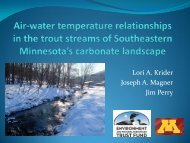Minnesota Water Resources Conference - Water Resources Center ...
Minnesota Water Resources Conference - Water Resources Center ...
Minnesota Water Resources Conference - Water Resources Center ...
You also want an ePaper? Increase the reach of your titles
YUMPU automatically turns print PDFs into web optimized ePapers that Google loves.
BOOK OF ABSTRACTS<br />
Tuesday, Monday, October 27 23<br />
Concurrent Sessions II 1:15–2:45<br />
Track A: Infiltration<br />
Tillage and Compost: Do they Improve Infiltration Rates of Compacted Soil<br />
Nicholas Olson, University of <strong>Minnesota</strong>, olso2113@umn.edu; John Gulliver, University of <strong>Minnesota</strong><br />
Soils on residential developments typically have lower stormwater infiltration rates than the soils they replace<br />
due to reduced topsoil depth and increased subsoil compaction from land development. Loss of infiltration<br />
leads to increased stormwater runoff and associated downstream problems: flooding, pollutant transport, and<br />
warming stream temperatures.<br />
This presentation explores improvements to stormwater infiltration rates by amending soils on residential<br />
developments with tillage methods and compost application. Field studies to measure how these soil<br />
amendments perform under actual conditions and the practical aspects of using them have been performed.<br />
Three types of assessment techniques were used to document these improvements: (1) capacity testing, (2)<br />
synthetic runoff testing, and (3) monitoring.<br />
The tillage and compost application improved infiltration rates over one season. The widespread application of<br />
our testing methods for the periodic assessment of infiltration rates will provide useful insight to proper design<br />
and maintenance schedules to achieve stormwater management goals.<br />
Understanding Bioretention in Cold Climates<br />
Jim Davidson, Dakota Soil and <strong>Water</strong> Conservation District, Jim.Davidson@co.dakota.mn,us; Nancy-Jeanne LeFevre, Emmons<br />
& Olivier <strong>Resources</strong>, Inc.; Gary Oberts, Emmons & Olivier <strong>Resources</strong>, Inc.<br />
A <strong>Water</strong> Environment Research Foundation funded three year study of four bioretention systems has recently<br />
been completed. The study focused on the movement of water into systems located in Stillwater, Burnsville,<br />
Cottage Grove and West St. Paul. A small amount of data was also collected from a Ramsey-Washington<br />
Metro <strong>Water</strong>shed District office bioretention cell. The three year effort collected winter data on soil moisture,<br />
precipitation, air and water temperature, frost penetration, and response to direct discharge volume testing<br />
with control and salt-dosed synthetic runoff water. Measured responses reveal a dramatic range of performance<br />
including rapid infiltration during varying cold climate conditions. Design recommendations for creating or<br />
retrofitting effective bioretention systems will be given.<br />
The 1' Infiltration Standard for <strong>Water</strong> Quality; One Year Later<br />
Forrest Kelley, Capitol Region <strong>Water</strong>shed District, forrest@capitolregionwd.org<br />
The Capitol Region <strong>Water</strong>shed District (CRWD), a densely populated urban watershed district located in St.<br />
Paul, MN adopted rules effective October 1, 2006. The rules require development and redevelopment projects<br />
over one acre to retain stormwater runoff onsite in the amount equivalent to the first 1”of rainfall over the entire<br />
site impervious area. The new rules apply to both public and private projects including street reconstruction.<br />
In the first year of implementation, 28 permits were issued. A variety of emerging technologies have been used<br />
to achieve the infiltration and water quality standards. Municipalities have incorporated infiltration BMPs into<br />
street projects and documented the costs associated with achieving the new stormwater rules, and staff have<br />
collected cost data for the BMPs installed in the private sector. Alternative treatment options have been utilized<br />
to address site constraints such as bedrock conditions, contaminated soils, and space availability.<br />
25 <strong>Minnesota</strong> <strong>Water</strong> <strong>Resources</strong> <strong>Conference</strong>, October 27–28, 2008
















